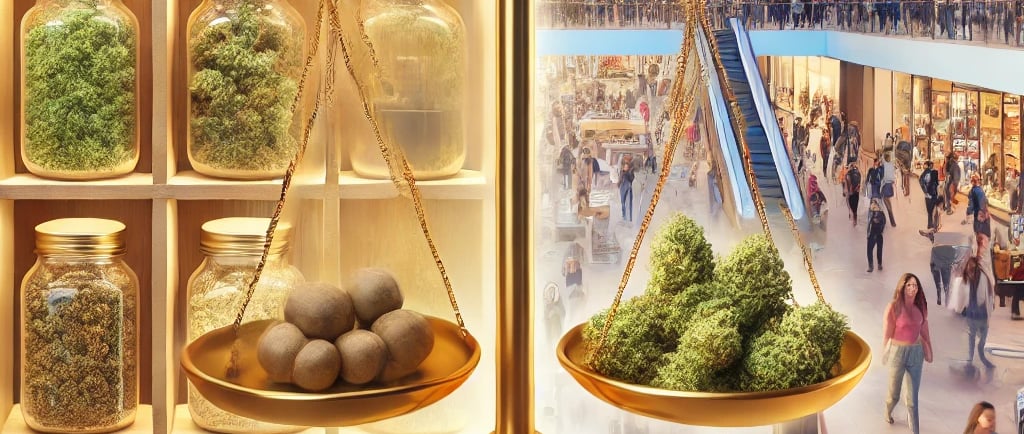Is Cannabis Consumption Comparable to Modern Consumerism
In recent years, the global acceptance and legalization of cannabis have grown significantly, leading to its increasing normalization as both a medicinal and recreational product. However, the question arises: can cannabis consumption be considered a form of mass consumption comparable to modern consumerism, particularly in sectors like shopping, technology, or fast-moving consumer goods? Let’s dive into this comparison by examining key factors such as market growth, consumer behavior, cultural impact, and sustainability.
CANNABIS GUIDE
12/20/20243 min read


1. Market Growth: Cannabis vs. Consumer Goods
Cannabis
The cannabis market has witnessed exponential growth due to legalization efforts and rising demand.
Global Growth: By 2028, the cannabis industry is projected to exceed $90 billion globally, with medicinal and recreational cannabis leading the charge.
Product Diversification: Cannabis consumption includes flowers, edibles, oils, and wellness products, catering to a broad demographic.
Emerging Markets: Countries like Canada, the U.S., and parts of Europe (including Spain) are driving the industry forward.
Consumer Goods and Technology
Modern consumerism spans a wide range of industries, including shopping (fashion, food, retail) and technology (smartphones, software, gadgets).
Scale: Retail and technology sectors dwarf cannabis in size, with global retail sales exceeding $25 trillion and the tech market growing rapidly.
Innovation: Regular product launches (e.g., new smartphones or seasonal fashion collections) sustain consumer interest and spending.
Comparison: Cannabis is a rapidly growing niche market compared to the entrenched dominance of consumer goods and technology, though it shows potential to disrupt traditional sectors like wellness and pharmaceuticals.
2. Consumer Behavior: Cannabis as a Commodity
Cannabis Consumption Patterns
Recreational Use: Many consumers use cannabis for relaxation, creativity, or social bonding, similar to how people engage with entertainment products.
Medicinal Use: Patients with conditions like chronic pain or anxiety rely on cannabis products, contributing to consistent demand.
Frequency: While some consumers use cannabis daily, others use it occasionally, depending on their needs.
Consumerism Trends
Shopping Habits: Modern consumerism is characterized by impulse purchases, frequent upgrades (e.g., in technology), and brand loyalty.
Emotional Connection: Buying is often tied to emotional gratification, similar to the sense of relaxation or relief cannabis can provide.
Comparison: Cannabis consumption mirrors consumerism in its diversity and emotional fulfillment but differs in frequency and motivations, which often include medicinal needs rather than pure gratification.
3. Cultural Impact: Cannabis vs. Mass Consumerism
Cannabis Culture
Cannabis has its own subculture, blending medicinal, recreational, and social aspects.
Acceptance: As stigma diminishes, cannabis is increasingly seen as part of a modern lifestyle.
Tourism: Destinations like Amsterdam and Barcelona attract cannabis enthusiasts, showing its cultural reach.
Community: Cannabis social clubs and dispensaries foster a sense of belonging, unlike the solitary nature of shopping.
Consumerism’s Influence
Global Phenomenon: From Black Friday to the latest iPhone release, consumerism influences cultural and economic trends worldwide.
Social Status: Modern consumerism often revolves around displaying wealth or status through possessions.
Comparison: Cannabis consumption is still emerging as a cultural force compared to the omnipresent nature of consumerism, but its social and medicinal value could create a broader impact over time.
4. Sustainability: The Green Paradox
Cannabis
Potential for Sustainability: Cannabis has the potential to be eco-friendly when cultivated responsibly (e.g., organic farming or using renewable energy).
Challenges: High energy use in indoor growing operations and packaging waste can impact the environment.
Industrial Hemp: The use of hemp for textiles and bioplastics offers sustainable alternatives in consumer goods.
Modern Consumerism
Environmental Cost: Fast fashion, tech waste, and overproduction contribute to pollution and climate change.
Circular Economy: Efforts like recycling programs and sustainable product lines are still in their infancy compared to the scale of environmental damage.
Comparison: Cannabis could have a more sustainable future if prioritized, while modern consumerism faces significant challenges in reducing its ecological footprint.
5. The Future of Cannabis and Consumerism
As cannabis becomes more integrated into mainstream culture, its consumption could reflect certain aspects of modern consumerism:
Brand Loyalty: Premium cannabis brands and products are emerging, encouraging similar consumer behaviors seen in the tech or fashion industries.
Innovation: Cannabis companies are constantly innovating, creating edibles, drinks, and wellness products tailored to consumer preferences.
Global Reach: With legalization expanding, cannabis has the potential to become a global commodity.
However, cannabis consumption differs in that it often fulfills therapeutic and medicinal needs rather than purely material desires, setting it apart from typical consumer goods.
Conclusion
While cannabis consumption shares similarities with modern consumerism—such as brand loyalty, emotional fulfillment, and market growth—it is still a niche compared to the massive scale of shopping and technology consumption. However, its unique blend of recreational, medicinal, and cultural significance makes it more than just another consumer product. As the cannabis market grows and societal acceptance continues to rise, it could reshape how we view consumption, prioritizing well-being and sustainability over materialism.
